BA-Walking-Tours.com
Buenos Aires Walking Tours
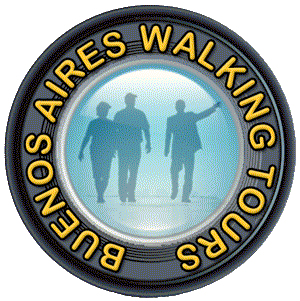
|
Private-Buenos-Aires-Tours.com
BA-Walking-Tours.com Buenos Aires Walking Tours |

|

|
| (Elegant & fun: Recoleta has much more than most tourists get to know...) |
Book Now
• Description: Private tour (2 ppl. min. --or slight surcharge) Scroll (way) down for extensive details!
• When: Recommended 9:30am or 2:00pm (or ask!) daily 365 days/year, rain or shine
• Duration: 3 hours (approximately)
• Price: Price for 2 people, $90 each (includes admission cost). Click 'Book Now' for single-walker and small-groups. Contact us for large group pricing.
• Meet: Hotel pickup is available at downtown hotels for a small additional fee (USD $20) if you let us know with at least 24hs advance advise. Otherwise your guide will wait for you at the door, outside the 'La Biela' cafe, corner of 596 Quintana Ave. by the huge tree and red telephone booth, holding a small 'BA-Walking-Tours' sign. Get printable, bilingual ('good-for-taxi' or asking) directions here, or see map here.
• Note: After this ultra-enjoyable walk you will understand Buenos Aires (and Argentina!!) much better. It includes over 25 main city landmarks (different from our other walks). This is not a strenuous walk and full itinerary will be covered depending on time and circumstances at time of tour. At some point (time permitting) we may stop for coffee or refreshments at some emblematic cafe of cultural or historical value. Snacks, drinks, hotel pickup, transportation, foot massage, mid-life-counseling, good sense of humour and gratuities are not included (actually massage, counseling and good sense of humour are not even available!).
• Some key sights:
 Our Recoleta Cemetery Tours show one of the world's extraordinary graveyards, a study in architecture and sculpture, a country's history, mores and soul. A number of tombs are national historic monuments. It is a place of spiritual beauty and extravagant taste. And thanks to Madonna and Broadway, it is hotter than ever as a tourist attraction. Travelers stream through the portal, cameras in hand, and ask the custodians the way to ''Evita.'' (Some even ask for ''Madonna''!).
(top...)
Our Recoleta Cemetery Tours show one of the world's extraordinary graveyards, a study in architecture and sculpture, a country's history, mores and soul. A number of tombs are national historic monuments. It is a place of spiritual beauty and extravagant taste. And thanks to Madonna and Broadway, it is hotter than ever as a tourist attraction. Travelers stream through the portal, cameras in hand, and ask the custodians the way to ''Evita.'' (Some even ask for ''Madonna''!).
(top...) Every day, busloads of tourists visit the black granite tomb of Evita Peron at Recoleta Cemetery in Buenos Aires. They listen to a few words from their tour guide, snap pictures and move on, rarely stopping to appreciate the grandeur of one of the world's most significant graveyards.
Sitting on a four-block area of the city's most expensive real estate, the 183-year-old cemetery is in grave need of restoration.
Marble tombs are being eaten away by acid rain, and their stucco ornaments are also dissolving, exposing brick interiors. Some historically significant tombs are being destroyed by human hands, through neglect or modernization.
This is one of the five most important cemeteries in the world as Recoleta represents an important historical moment for the city of Buenos Aires (one ot the ten largest cities in the world) and how it was forming at the time.
(top...)
Every day, busloads of tourists visit the black granite tomb of Evita Peron at Recoleta Cemetery in Buenos Aires. They listen to a few words from their tour guide, snap pictures and move on, rarely stopping to appreciate the grandeur of one of the world's most significant graveyards.
Sitting on a four-block area of the city's most expensive real estate, the 183-year-old cemetery is in grave need of restoration.
Marble tombs are being eaten away by acid rain, and their stucco ornaments are also dissolving, exposing brick interiors. Some historically significant tombs are being destroyed by human hands, through neglect or modernization.
This is one of the five most important cemeteries in the world as Recoleta represents an important historical moment for the city of Buenos Aires (one ot the ten largest cities in the world) and how it was forming at the time.
(top...)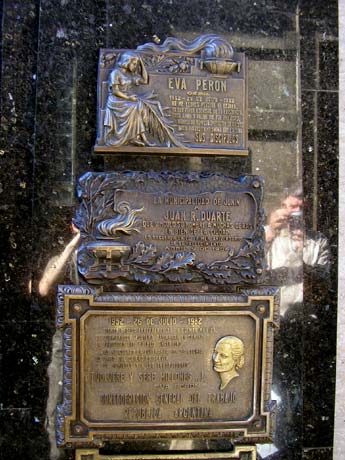 The labyrinthine necropolis is laid out like a town. There is no map and only one sign -- to Mausoleo Sarmiento, a soaring obelisk crowned with a condor. It commemorates the Argentine hero Domingo Faustino Sarmiento, President, writer and educator, who died Sept. 11, 1888. The predominant color is gray.
The entrance is post-colonial in style with four columns, a peristyle and tall wrought-iron gates. Just inside is the main avenue, an address of choice lined with cypress trees, stone benches and some 50 showpiece mausoleums. A towering bronze statue of El Redentor, The Redeemer, is in the center. Along the avenue visitors admire the white marble beauty of Luz Maria Garcia Velloso in a softly draped dress, lying asleep among sculptured roses on a white marble sarcophagus. A bronze ship atop a green column celebrates Adm. Guillermo Brown (an Irish adventurer/corsair who did well in Argentina), who gave ''days of glory and triumph in the year 1814.'' His neighbor, Gen. Tomas Guido, a friend and colleague of the great Libertador General San Martin, is buried in a little stone grotto.
(top...)
The labyrinthine necropolis is laid out like a town. There is no map and only one sign -- to Mausoleo Sarmiento, a soaring obelisk crowned with a condor. It commemorates the Argentine hero Domingo Faustino Sarmiento, President, writer and educator, who died Sept. 11, 1888. The predominant color is gray.
The entrance is post-colonial in style with four columns, a peristyle and tall wrought-iron gates. Just inside is the main avenue, an address of choice lined with cypress trees, stone benches and some 50 showpiece mausoleums. A towering bronze statue of El Redentor, The Redeemer, is in the center. Along the avenue visitors admire the white marble beauty of Luz Maria Garcia Velloso in a softly draped dress, lying asleep among sculptured roses on a white marble sarcophagus. A bronze ship atop a green column celebrates Adm. Guillermo Brown (an Irish adventurer/corsair who did well in Argentina), who gave ''days of glory and triumph in the year 1814.'' His neighbor, Gen. Tomas Guido, a friend and colleague of the great Libertador General San Martin, is buried in a little stone grotto.
(top...)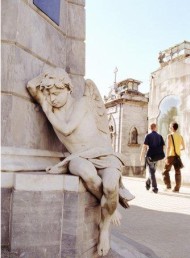 In every graveyard there is a story behind every grave. In Recoleta the stories are those of a nation, and there are some good ones. In 1828 Gen. Juan Lavalle ordered the execution of Gen. Manuel Dorrego, now his neighbor in death. In the biography of Juan Facundo Quiroga by Sarmiento, ''Facundo: Civilization and Barbarism,'' the author portrayed Quiroga as a barbarian. Now they, too, are posthumous neighbors.
One most astonishing story is the attempted Aramburu-Evita cadaver exchange. When Eva Peron died, at age 33 in 1952, her body was embalmed and kept in the General Confederation of Labor headquarters. Gen. Pedro E. Aramburu, a political enemy of the Perons who was de facto President of the junta that ruled Argentina, ordered the kidnapping of her corpse, which was sent in secret to a cemetery in Italy. The Montoneros, a guerrilla group of Peronist loyalists, abducted and executed Aramburu, then kept his remains as ransom for the return of ''Companera'' Evita's. The police recovered Aramburu's body. But when Evita's body didn't show up, the Montoneros later robbed Aramburu's grave. Evita's mummy was eventually sent to Juan Peron in exile in Madrid and later returned to Buenos Aires, restored, and nearly 25 years after her death, in 1976, buried a few blocks from Aramburu. Juan Peron is buried in Cementerio de la Chacarita, a more populist cemetery in the city.
(top...)
In every graveyard there is a story behind every grave. In Recoleta the stories are those of a nation, and there are some good ones. In 1828 Gen. Juan Lavalle ordered the execution of Gen. Manuel Dorrego, now his neighbor in death. In the biography of Juan Facundo Quiroga by Sarmiento, ''Facundo: Civilization and Barbarism,'' the author portrayed Quiroga as a barbarian. Now they, too, are posthumous neighbors.
One most astonishing story is the attempted Aramburu-Evita cadaver exchange. When Eva Peron died, at age 33 in 1952, her body was embalmed and kept in the General Confederation of Labor headquarters. Gen. Pedro E. Aramburu, a political enemy of the Perons who was de facto President of the junta that ruled Argentina, ordered the kidnapping of her corpse, which was sent in secret to a cemetery in Italy. The Montoneros, a guerrilla group of Peronist loyalists, abducted and executed Aramburu, then kept his remains as ransom for the return of ''Companera'' Evita's. The police recovered Aramburu's body. But when Evita's body didn't show up, the Montoneros later robbed Aramburu's grave. Evita's mummy was eventually sent to Juan Peron in exile in Madrid and later returned to Buenos Aires, restored, and nearly 25 years after her death, in 1976, buried a few blocks from Aramburu. Juan Peron is buried in Cementerio de la Chacarita, a more populist cemetery in the city.
(top...)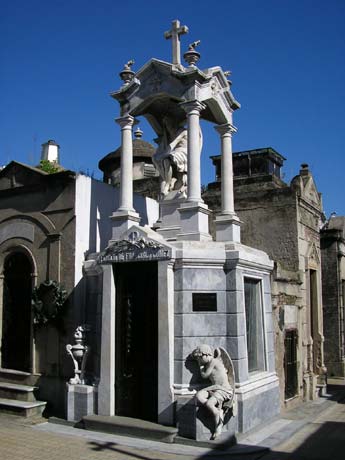 But Recoleta is not only a story of past power and glory. It is a place that is part of Buenos Aires everyday life. Cemetery custodians polish marble, cradle cats, chat on tomb steps and may open tomb doors for travelers who want to see an interior. (A tip is always welcome, but not mandatory.) Many tombs are lovingly personal, with interiors -- visible through windows or doors -- adorned with symbolic objects and mementoes: exquisite lace cloths over a coffin, a cross encrusted with gems. Behind one wrought-iron door there is a broken chair of carved wood and cane. Inside another there is a black and white photograph of a beautiful woman in a white feather boa.
Family, friends, admirers, patriots, visit faithfully. There's usually someone around, and the cemetery is especially busy on weekends. Visitors replenish flowers in vases, polish silver handles on coffins, leave messages, sit and reflect.
(top...)
But Recoleta is not only a story of past power and glory. It is a place that is part of Buenos Aires everyday life. Cemetery custodians polish marble, cradle cats, chat on tomb steps and may open tomb doors for travelers who want to see an interior. (A tip is always welcome, but not mandatory.) Many tombs are lovingly personal, with interiors -- visible through windows or doors -- adorned with symbolic objects and mementoes: exquisite lace cloths over a coffin, a cross encrusted with gems. Behind one wrought-iron door there is a broken chair of carved wood and cane. Inside another there is a black and white photograph of a beautiful woman in a white feather boa.
Family, friends, admirers, patriots, visit faithfully. There's usually someone around, and the cemetery is especially busy on weekends. Visitors replenish flowers in vases, polish silver handles on coffins, leave messages, sit and reflect.
(top...)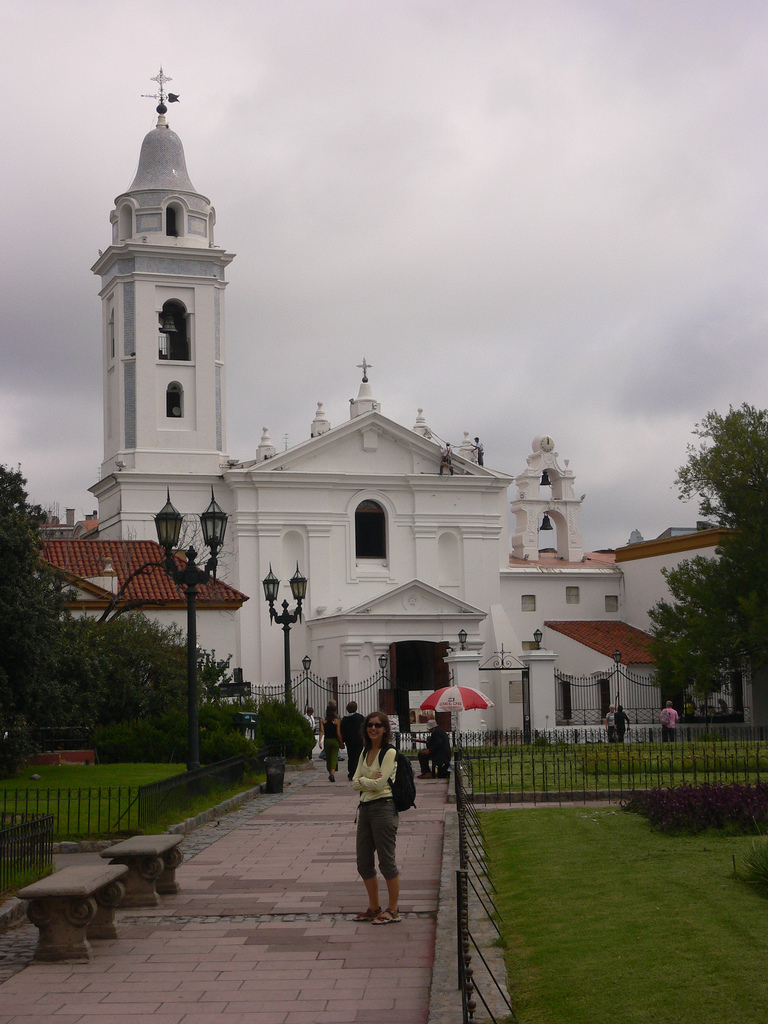 Next we visit beautiful Pilar church (amongst the oldest in the city).
Recoleta's Nuestra Senora del Pilar church is a nice reminder that Catholic art is timelessly elegant. The church is mainly white and Navy; simple and pure and has no paintings in the ceilings, but the altar is solid silver (sent from Peru at the time of the colony) and there are numerous examples of beautiful spanish baroque and rococo all around the walls, together with beautiful carvings gifted by the other neighbouring territories at colonial times. Thedre is also an interesting museum inside the church with many antique reliques and books.
(top...)
Next we visit beautiful Pilar church (amongst the oldest in the city).
Recoleta's Nuestra Senora del Pilar church is a nice reminder that Catholic art is timelessly elegant. The church is mainly white and Navy; simple and pure and has no paintings in the ceilings, but the altar is solid silver (sent from Peru at the time of the colony) and there are numerous examples of beautiful spanish baroque and rococo all around the walls, together with beautiful carvings gifted by the other neighbouring territories at colonial times. Thedre is also an interesting museum inside the church with many antique reliques and books.
(top...)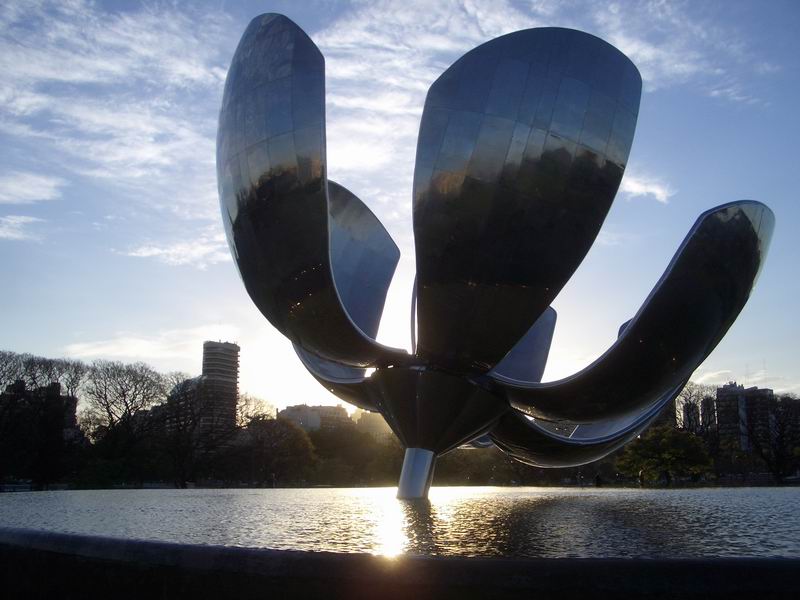 We walk by the side of the museum and we can see to our right the large greek-temple-like massive building of the Law School of the University of Buenos Aires and to our right a beautiful and unique piece of art: the generic flower (Floralis Generica). The 'Floralis Generica' is a gigantic mobile sculpture with a flower shape. It opens with the sunlight and closes during the night. Donated to the city by the arquitect Eduardo Catalano (costed him 5 million dollars), it has six metallic petals of almost 26 meters height. The flower opens by means of a computerized hydraulic device in the morning and closes during the sunset. It is located atop a water mirror, surrounded by a cascade-water fountain. The flower stays completely open during national holidays, Christmas and New Year's Eve. It is beautiful by day and also by night, as it is colourfully iliminated.
(top...)
We walk by the side of the museum and we can see to our right the large greek-temple-like massive building of the Law School of the University of Buenos Aires and to our right a beautiful and unique piece of art: the generic flower (Floralis Generica). The 'Floralis Generica' is a gigantic mobile sculpture with a flower shape. It opens with the sunlight and closes during the night. Donated to the city by the arquitect Eduardo Catalano (costed him 5 million dollars), it has six metallic petals of almost 26 meters height. The flower opens by means of a computerized hydraulic device in the morning and closes during the sunset. It is located atop a water mirror, surrounded by a cascade-water fountain. The flower stays completely open during national holidays, Christmas and New Year's Eve. It is beautiful by day and also by night, as it is colourfully iliminated.
(top...)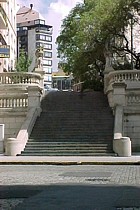 Next, we will walk by a park with large monuments representing the Uruguayan independence hero Gral. Artigas and across TV Channel 7, broadcast station, to just stroll briefly through one of the nicest and most exclusive neighbourhoods: Palermo chico. Designed in a secluded, labyrinthic way, it resembles a spider web, and its circulation is an esoteric mistery (they say it is purposefully so to deter visitors and kidnappers, which would get entangled in its labyrinthic streets) and without shops to cause any circulation or annoyance. The styles are eclectic and diverse, but all beautiful and comfortable. In here you live at almost no distance from downtown, but unlike the dense highly-populated buildings of Barrio Norte, Belgrano or the other high-level neighbourhoods, here you live like if you were in a private country club: in stand-alone houses, most of them with beautiful inner gardens.
(top...)
Next, we will walk by a park with large monuments representing the Uruguayan independence hero Gral. Artigas and across TV Channel 7, broadcast station, to just stroll briefly through one of the nicest and most exclusive neighbourhoods: Palermo chico. Designed in a secluded, labyrinthic way, it resembles a spider web, and its circulation is an esoteric mistery (they say it is purposefully so to deter visitors and kidnappers, which would get entangled in its labyrinthic streets) and without shops to cause any circulation or annoyance. The styles are eclectic and diverse, but all beautiful and comfortable. In here you live at almost no distance from downtown, but unlike the dense highly-populated buildings of Barrio Norte, Belgrano or the other high-level neighbourhoods, here you live like if you were in a private country club: in stand-alone houses, most of them with beautiful inner gardens.
(top...)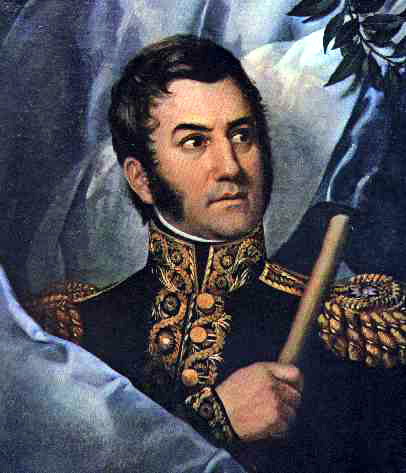 Now we go past a replica of the house where San Martin exiled himself in Grand Bourg, France. Jose de San Martin was born on February 25, 1778 in Yapeyu, located in the viceroyalty of the Rio de la Plata', which is now known as eastern Argentina. In 1784, when San Martin was six years old, the family returned to Spain, where he was educated at the "Seminario de Nobles". He started his military career early serving as an army officer against the forces of Napoleon between 1808 and 1811. Even though San Martin was loyal towards his mother country (Spain) when he fought against Napoleon, he disliked the traditional absolute monarchy and the existing colonial system. In 1811, he decided to resign from Spanish service. After meeting revolutionary Spanish Americans in London, England, he sailed for Buenos Aires, and was almost immediately taken into service in the revolutionary regime. As a very experienced soldier, he was a great asset in the revolutionary movement in South America.
Now we go past a replica of the house where San Martin exiled himself in Grand Bourg, France. Jose de San Martin was born on February 25, 1778 in Yapeyu, located in the viceroyalty of the Rio de la Plata', which is now known as eastern Argentina. In 1784, when San Martin was six years old, the family returned to Spain, where he was educated at the "Seminario de Nobles". He started his military career early serving as an army officer against the forces of Napoleon between 1808 and 1811. Even though San Martin was loyal towards his mother country (Spain) when he fought against Napoleon, he disliked the traditional absolute monarchy and the existing colonial system. In 1811, he decided to resign from Spanish service. After meeting revolutionary Spanish Americans in London, England, he sailed for Buenos Aires, and was almost immediately taken into service in the revolutionary regime. As a very experienced soldier, he was a great asset in the revolutionary movement in South America.
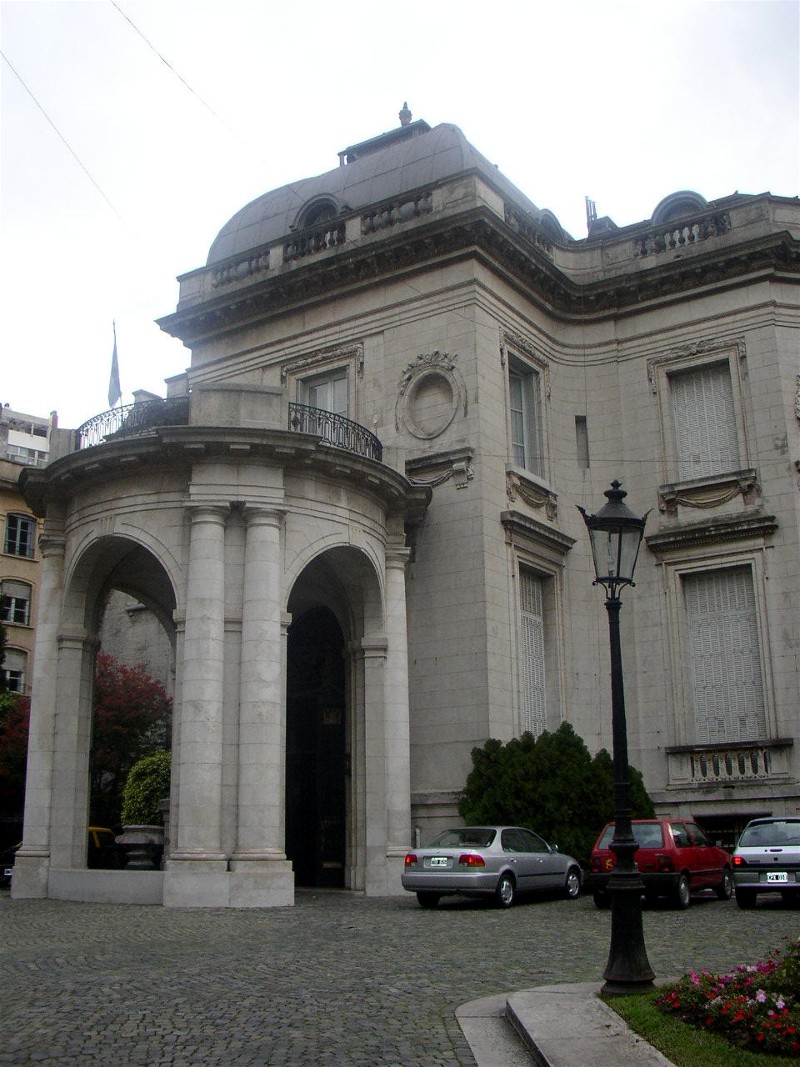 We will now continue our walk across Av. del Libertador (actually this is an indirect way of addressing San Martin, the libertador) to the Errasuriz Palace.Since 1937, this stunning neoclassical mansion, formerly the Palacio Errazuriz, has operated as a museum devoted to the decorative arts. (It was declared an official historic landmark in 1998.) Built in 1911 by French architect Rene Sergent for a Buenos Aires power couple (Josefina de Alvear and Matias Errazuriz Ortuzar), the house continues to wow visitors by providing a peek into just how good Argentina's filthy rich once had it. But there are also som 4,000 amazing objets to go along with the eye-popping architecture, including an arresting El Greco in the 54-by-64-foot Gran Hall, and two gigantic antique and most valuable tapestries that are attributed to have been the cause this house was built (yes, it is in record that this huge palace was designed around housing this tapestries on the longer wall of its main hall).
(top...)
We will now continue our walk across Av. del Libertador (actually this is an indirect way of addressing San Martin, the libertador) to the Errasuriz Palace.Since 1937, this stunning neoclassical mansion, formerly the Palacio Errazuriz, has operated as a museum devoted to the decorative arts. (It was declared an official historic landmark in 1998.) Built in 1911 by French architect Rene Sergent for a Buenos Aires power couple (Josefina de Alvear and Matias Errazuriz Ortuzar), the house continues to wow visitors by providing a peek into just how good Argentina's filthy rich once had it. But there are also som 4,000 amazing objets to go along with the eye-popping architecture, including an arresting El Greco in the 54-by-64-foot Gran Hall, and two gigantic antique and most valuable tapestries that are attributed to have been the cause this house was built (yes, it is in record that this huge palace was designed around housing this tapestries on the longer wall of its main hall).
(top...)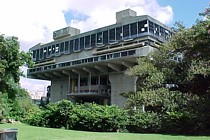 After leaving this Palace, we walk across the Argentine Automobile Club, where we can enter and take a quick look at the antique car museum, which includes the first car built in argentina and a few other amazing cars, including a 1904 Cadillac, you would hardly recognize as such.
(top...)
After leaving this Palace, we walk across the Argentine Automobile Club, where we can enter and take a quick look at the antique car museum, which includes the first car built in argentina and a few other amazing cars, including a 1904 Cadillac, you would hardly recognize as such.
(top...)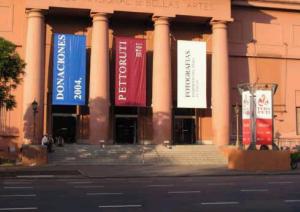 The publicly owned National Museum of Fine Arts in Buenos Aires is the principal showcase for the art collections of Argentina. Its history appears to be a long struggle between, on the one hand, the desire of art lovers and collectors for an appropriate repository and, on the other, bureaucratic disinterest and inertia. (Recent allegations of corruption and profiteering at the museum's highest level have precipitated an overdue change in its leadership.) As early as 1870, one collector bequeathed fifty paintings to the state on the condition that they be the basis for a museum. Not until 1895 was the museum organized and it opened its first exhibit in rented space in a department store on Christmas day, 1896. By 1908 the collection had grown to nearly 3,500 pieces, but a permanent home for the museum was not achieved for another quarter of a century.
(top...)
The publicly owned National Museum of Fine Arts in Buenos Aires is the principal showcase for the art collections of Argentina. Its history appears to be a long struggle between, on the one hand, the desire of art lovers and collectors for an appropriate repository and, on the other, bureaucratic disinterest and inertia. (Recent allegations of corruption and profiteering at the museum's highest level have precipitated an overdue change in its leadership.) As early as 1870, one collector bequeathed fifty paintings to the state on the condition that they be the basis for a museum. Not until 1895 was the museum organized and it opened its first exhibit in rented space in a department store on Christmas day, 1896. By 1908 the collection had grown to nearly 3,500 pieces, but a permanent home for the museum was not achieved for another quarter of a century.
(top...)|
Reservations (Whatsapp enabled) in English, click on number below: Tel. +(54 911) 6566-5050 |